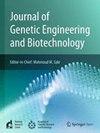从伊拉克本地冻鸡尸体中分离的共生奇异变形杆菌的多药耐药性和毒力分析
IF 2.8
Q3 Biochemistry, Genetics and Molecular Biology
Journal of Genetic Engineering and Biotechnology
Pub Date : 2025-04-26
DOI:10.1016/j.jgeb.2025.100490
引用次数: 0
摘要
本研究旨在了解当地屠宰场冷冻鸡胴体中奇异变形杆菌的流行情况。它评估了9种抗菌剂的活性以及抗菌素抗性基因和毒力基因的存在。从5家伊拉克当地公司收集了30个样本。然后用聚合酶链反应(PCR)检测耐药基因和毒力因子相关基因。结果发现,9株奇异假单胞菌对萘啶酸和阿奇霉素均耐药的比例为100%,其次为甲氧苄啶-磺胺甲恶唑(sul1)的比例为88.8%,对亚胺培南和美罗培南的比例为88.8%,对头孢他啶和头孢噻肟的比例为88.8%。所有分离株(100%)对至少3类抗生素耐药,并被归类为多重耐药。PCR结果显示,最常见的耐药基因为DNA旋转酶亚基A基因(gyrA)(100%)、二氢teroate合成酶基因(sul1)(88.8%)和氟脲醇耐药基因(floR)(88.8%),其次为氨基糖苷n -乙酰转移酶基因(acc(6′)-lb)(44.4%)和大环内酯磷酸转移酶基因(mphA)(33.3%)。此外,在所有菌株中均存在相同比例(100%)的毒力基因锌金属蛋白酶A基因(zapA)、单磷酸尿苷合成酶基因(uraC)、组蛋白修饰蛋白A基因(hpmA)、鞭毛蛋白A基因(flaA)、抗sigma因子RsbA基因(RsbA)和多药耐药蛋白A基因(mrpA)。我们的研究强调,奇异变形杆菌作为一种多药耐药模式具有高频率的抗生素耐药,并且具有高水平的毒力因子基因检测,可能对食品安全和人类健康构成威胁。对从鸡肉中分离的奇异假单胞菌进行系统发育树分析,发现与数据库菌株高度相似。本文章由计算机程序翻译,如有差异,请以英文原文为准。
Multidrug resistance and virulence profile of the commensal Proteus mirabilis isolated from a native Iraqi frozen chicken carcass
This study aimed to determine the prevalence of Proteus mirabilis in frozen chicken carcass from local slaughterhouse. It assesses the activities of nine antimicrobial agents and the presence of antimicrobial resistance genes and virulence genes. Thirty samples were collected from five local Iraqi companies. and then the antibiotic-resistance genes and virulence factor-related genes were detected via polymerase chain reaction (PCR). The results revealed that Nine P. mirabilis isolates were recovered, and the majority of the isolates were resistant to both nalidixic acid and azithromycin at a ratio of (100 %), followed by trimethoprim-sulfamethoxazole (sul1) (88.8 %), whereas the isolates were susceptible to imipenem and meropenem, and both ceftazidime and cefotaxime were efficient at a ratio of (88.8 %). All the isolates (100 %) were resistant to at least three classes of antibiotics and were classified as multidrug resistant. The PCR results indicated that the most common resistance genes were DNA Gyrase Subunit A Gene (gyrA) (100 %), Dihydropteroate Synthase Gene (sul1) (88.8 %), and Florenicol Resistance Gene (floR) (88.8 %), followed by Aminoglycoside N-Acetyltransferase Gene (acc (6′)-lb) (44.4 %) and Macrolide Phosphotransferase Gene (mphA) (33.3 %). In addition, the virulence genes Zinc Metalloprotease A Gene (zapA), Uridine Monophosphate Synthase Gene (uraC), Histone-Modifying Protein A Gene (hpmA), Flagellin A Gene (flaA), Anti-Sigma Factor RsbA Gene (rsbA), and Multidrug Resistance Protein A Gene (mrpA) were found in the same proportion (100 %) of all P. mirabilis isolates. Our study emphasized that Proteus mirabilis has a high frequency of antibiotic resistance as a multidrug resistance pattern and furthermore demonstrated a high level of virulence factor gene detection, which might be a threat to food safety and human health. The phylogenetic tree analysis of the P. mirabilis isolates from chicken meat revealed high similarity to the database strain.
求助全文
通过发布文献求助,成功后即可免费获取论文全文。
去求助
来源期刊

Journal of Genetic Engineering and Biotechnology
Biochemistry, Genetics and Molecular Biology-Biotechnology
CiteScore
5.70
自引率
5.70%
发文量
159
审稿时长
16 weeks
期刊介绍:
Journal of genetic engineering and biotechnology is devoted to rapid publication of full-length research papers that leads to significant contribution in advancing knowledge in genetic engineering and biotechnology and provide novel perspectives in this research area. JGEB includes all major themes related to genetic engineering and recombinant DNA. The area of interest of JGEB includes but not restricted to: •Plant genetics •Animal genetics •Bacterial enzymes •Agricultural Biotechnology, •Biochemistry, •Biophysics, •Bioinformatics, •Environmental Biotechnology, •Industrial Biotechnology, •Microbial biotechnology, •Medical Biotechnology, •Bioenergy, Biosafety, •Biosecurity, •Bioethics, •GMOS, •Genomic, •Proteomic JGEB accepts
 求助内容:
求助内容: 应助结果提醒方式:
应助结果提醒方式:


